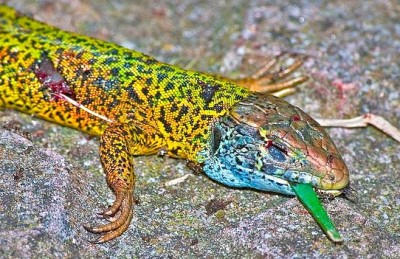What Is Rigor Mortis When Your Butchering Animals
Introduction
Although medical noesis has answered many questions regarding animal life, there are still many mysteries that face u.s.a.. And nowhere is the mystery of life and expiry more credible than when dealing with reptiles (Fig 1).

Effigy 1. This lizard appears to be expressionless, just is it? How can the veterinarian verify life (and death) in reptiles? Image by Eric Caballero.
Detecting the reptile eye rate
- Stethoscope: Fifty-fifty in the active, healthy reptile the stethoscope is mostly a useless piece of equipment. The presence of scales or the beat makes auscultation of the heart difficult, if non impossible, in many instances. Therefore coincident testing such as ultrasonography or electrocardiography is required.
- Doppler or ultrasound: A pediatric Doppler probe or ultrasound probe tin exist used to observe arterial claret flow. Identify the Doppler probe directly over the apex beat or an accessible artery. Utilize Doppler gel to raise contact betwixt the probe and the peel.
- Electrocardiogram (ECG): Alligator clips can be placed straight on the reptile's leathery pare or scales, yet recording potentials can be enhanced by attaching ECG clips to fine gauge hypodermic needles that have been placed in the appropriate locations. Loops of stainless steel suture can likewise be used as subcutaneous leads but this exercise is most ordinarily elected for anesthetic monitoring.
Brain death versus cardiac abort
Unfortunately ECG or Doppler readings can be misleading when verifying expiry in the reptile patient. Brain expiry can (apparently) precede asytole by many hours because the heart sometimes continues to trounce and the body tin can continue to writhe for many hours after brain activity has ceased. Alternatively the heart rate can slow so dramatically that the "reptile's centre rate tin can alter from beats per minute to minutes per beat…" (Mader 2006).
All reptile vets have a story like this…
Checking heart rate is just ONE part of the picture when verifying reptile death. All reptile veterinarians have a story of a "dead" patient that wakes upwardly 24 hours later—oftentimes with cypher more than fourth dimension or supplemental oestrus provided.
…Last nighttime on emergency I get a 6-year erstwhile l-lb tortoise, which had been "basking" at the lesser of the pool for about iii hours. Owners upset, 'effort everything' kind of situation. So the tortoise is room temperature, non breathing, flaccid, no deep pain– hook upwards the ECG, no electric action. I pick upwards the tortoise; concur it upside down and about half a gallon of water comes pouring out. Non practiced.
…Information technology gets busy, and virtually 2 hours later I hear this deep grunting sound. There's a couple of critical animals in the hospital, so I become worried and expect around – aught. A few minutes later the same thing happens – and I await downwardly to find the tortoise chewing on his ET tube!
…Now he's getting pissed – poked and prodded quite a few times, and I tin't fifty-fifty incorporate him in a muzzle, he'southward and so restless. Call the owners – they pretty much fall over themselves when I tell them to choice the tortoise upward. Makes me look like a champ, while honestly didn't do much more give it a good-natured whirl… goes to bear witness, you never know how [a reptile will] turn out. —Grand.Dekker, DVM; EBVE, Antioch, CA
There'south no middle vanquish, now what…?
AFTER euthanizing a reptile or proclaiming a reptile (probably) dead, merely BEFORE sending the patient domicile or performing a necropsy it is imperative to confirm (or ensure) that the animal is expressionless.
- Reptile muscles go through all the same stages of death seen in other species: primary relaxation or flaccidity, rigor mortis or rigidity, followed by secondary relaxation. So if the brute appears to be in rigor it is likely dead (be sure to rule out tetany).
- Some other dominion of thumb when dealing with euthanized or dying reptiles is to wait 12 or preferably 24 hours after euthanasia to send the animal domicile with the owners.
- Adjunct procedures tin can too be performed to ensure death in a reptile Later on euthanizing the animate being and/or non detecting a heart rate.
- Decapitation with transection of the cervical spinal string or pithing the brain is frequently performed before necropsy (and Subsequently euthanasia)
- Some clinicians elect to place the reptile in the freezer AFTER euthanasia and not detecting a center charge per unit. Note: Freezing lone is NOT considered an acceptable method for euthanasia of Whatever species (AVMA 2007).
Visit Reptile Wild animals Euthanasia Techniques for more detailed information.
Summary
In conclusion, there is no 100% reliable style to verify decease in reptiles short of putrification or decapitation. For this reason, reptile veterinarians routinely look 12 to 24 hours later on declaring the animal deceased before releasing the body. Adjunct procedures, such as freezing, pithing, and decapitation, are also routinely performed as needed after euthanasia and after failure to detect a heartbeat.
References
References
AVMA. AVMA Console on Euthanasia. June 2007. Pp. 17-20. Available at https://www.avma.org/KB/Policies/Documents/euthanasia.pdf. Accessed on October 24, 2012.
Dekker M. Drowned tortoise with no vital signs was successfully revived. Veterinary Information Network website. Bachelor at http://world wide web.vin.com/Members/boards/discussionviewer.aspx?FirstMsg=ane&LastMsg=20&DocumentId=3580842. Last updated: 9/11/07. Accessed on Oct 22, 2012.
Johnson A, Clinton J, Stevens R. Turtle heart beats five days after death. Amer Biol Instructor 19(half dozen):176-177, 1957.
Mader DR. Euthanasia. In: Mader DR (ed). Reptile Medicine and Surgery, 2d edition. Saunders Elsevier; St. Louis: 2006. Pp. 564-568.
To cite this page:
Pollock C. How to verify life (and expiry) in reptiles. October 22, 2012. LafeberVet Spider web site. Available at https://lafeber.com/vet/how-to-verify-life-and-expiry-in-reptiles/
Source: https://lafeber.com/vet/how-to-verify-life-and-death-in-reptiles/
Posted by: thomasthadvating.blogspot.com

0 Response to "What Is Rigor Mortis When Your Butchering Animals"
Post a Comment